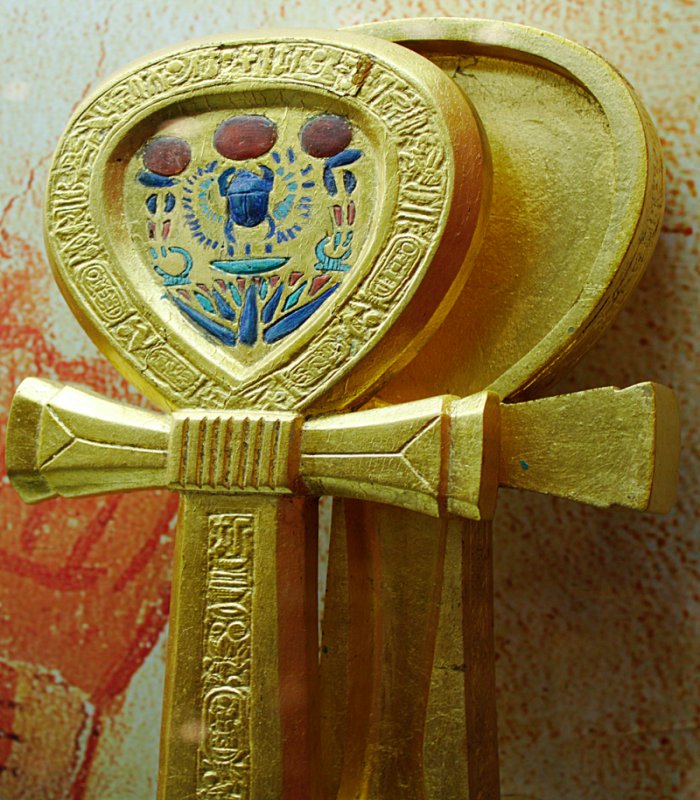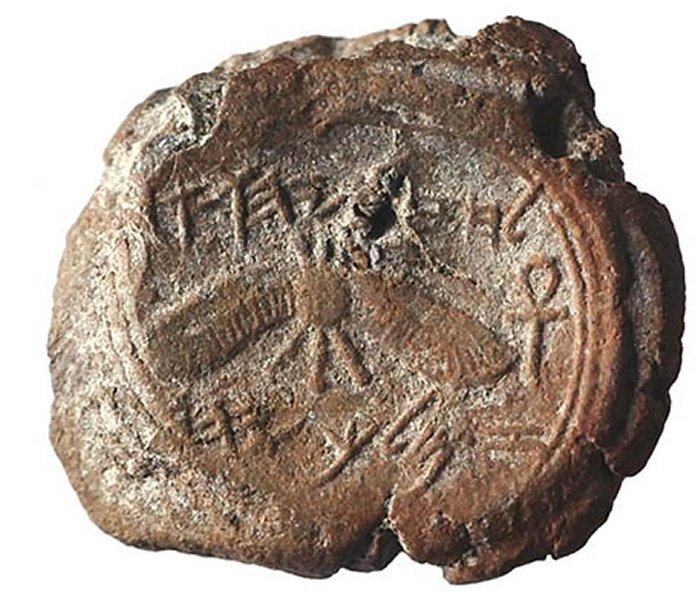What Is The Meaning Of Ankh – Ancient Egyptian Symbol
A. Sutherland - AncientPages.com - Different people have different religions. Each religion has its symbols and characteristic signs.
Egyptian Ankh. Image credit: Nachbarnebenan - Public Domain
Just as the symbol of Christianity has become the cross, known in several variants, and before it was a fish sign, so is the Ankh, a symbol of the ancient religion of Egypt.
Many Interpretations Of The Ankh
Some interpret this symbol according to its two parts – the oval shape symbolizes the eternity of living deities, and the cross that comes out of it is continuation and extension.
In Egyptian hieroglyphs since the Old Kingdom period, the Ankh symbolized life but not the 'life' (this everyday, ordinary life) we think of. The ancient Egyptians associated the Ankh with the soul's spiritual life, which most do not even think about daily.
But the Ankh is also the subject of other interpretations. It combines the two forces of life - the male and female symbols of Osiris and Isis.
It is the union between heaven and earth and unifying feminine and masculine principles.
First Dynasty stone dish in the shape of an ankh, embraced by a pair of hands representing ka.Image credit: Soutekh67 - CC BY-SA 4.0.
It also symbolized fertility as the sign's loop was associated with a woman's womb. Later, the Ankh was given a magical meaning as it was believed it possessed a mystic vital force.
Mystics and enthusiasts of secret knowledge in the 19th century and even the 20th century's New Age movements have considered the Ankh a powerful symbol of prosperity, health, good fortune, and protection against defeat, fall, and destruction.
Ankh Was Associated With Many Egyptian Deities
There are many depictions of Egyptian deities holding the Ankh. Maat, the goddess of truth, holds an ankh in her hand; however, the goddess Isis is most often seen carrying it. Also, Atum, the god of the sun from Heliopolis, and Sekhmet, a warrior goddess and a goddess of healing, were often depicted with the Ankh.
There are also representations of the pharaoh who stands between the gods and holds the Ankh in his palm. In this case, the sign emphasizes the pharaoh's divine nature.
Ankh Decorated Walls Of Egyptian Temples
In Egyptian tomb paintings and other art, the Ankh appears frequently. As a symbol of imperishable vital force, the Ankh was painted on the walls of the temples, stelae, and in friezes of objects, especially near the feet, to provide divine protection to the dead.
It often appears at the fingertips of a god or goddess in images representing the afterlife's deities conferring the gift of life on the dead person's mummy.
Left: Frieze of ankh, signs of djed and was at the top of the hieroglyph "all". Image credit: Ancient sculptor unknown; original photograph by Olaf Tausch. CC BY-SA 2.5; Right: Hathor presents the ankh to Queen Nefertari Merenmut. Scene from her tomb QV66, 13th century (19th) - Image upploader - Ramsis1978 - public domain
Numerous depictions show a symbolic combination of water and air in scenes when a god holds the Ankh before the king's nose, giving him the 'breath of life, or when a stream of water forming the Ankh runs over the king during ceremonial purification.
The Ankh is also known as the Egyptian Cross or crux ansata, which in Latin means "cross with a handle."
When Christianity came to Egypt, the ancient Egyptian symbol of Ankh was taken over by the fourth-century Coptic Christians, and their church adopted the Ankh as its unique form of the Christian cross because of its cruciform shape.
Interestingly, the Ankh, symbolizing life and accompanied by a two-winged sun and wings turned downward, was depicted on an impression of the royal seal of King Hezekiah (727–698 BC).
The artifact was unearthed during the Ophel excavations at the foot of the Temple Mount in 2015.
Ankh Is A Good Amulet – But Not For Everyone
The Ankh is a suitable amulet for those who wish to demonstrate their spiritual rather than religious beliefs.
The royal seal of Hezekiah, king of Judah. The ankh is clearly visible. Photo: Courtesy of Dr. Eilat Mazar/ Ouria Tadmor
Otherwise, the Ankh is the attribute of the god Amun ('the hidden one'), King of the Gods, one of the most powerful gods in Egypt. Egyptians frequently carried it as an amulet, sometimes accompanied by two other hieroglyphs symbolizing 'strength' and 'health. Ancient Egyptian mirrors were often shaped as the Ankh.
This universal symbol has accompanied and influenced humanity in all ages and continues to influence modern people.
The Ankh is one of many important ancient Egyptian symbols.
Written by – A. Sutherland AncientPages.com Staff Writer
Updated on Sep 21, 2023
Copyright © AncientPages.com All rights reserved. This material may not be published, broadcast, rewritten or redistributed in whole or part without the express written permission of AncientPages.com
More From Ancient Pages
-
 Magnificent Ancient Treasures Of The Mysterious Kangju Kingdom Found By Archaeologists
Archaeology | Jun 11, 2024
Magnificent Ancient Treasures Of The Mysterious Kangju Kingdom Found By Archaeologists
Archaeology | Jun 11, 2024 -
 Odeuropa – Unusual Project Will Recreate The Smells Of Old Europe And Store The Scents In A Library
News | Nov 17, 2020
Odeuropa – Unusual Project Will Recreate The Smells Of Old Europe And Store The Scents In A Library
News | Nov 17, 2020 -
 Indigenous Communities Used The Caribbean Sea As An Aquatic Highway
Archaeology | Jun 23, 2022
Indigenous Communities Used The Caribbean Sea As An Aquatic Highway
Archaeology | Jun 23, 2022 -
 Evidence Of Copper Processing Unearthed At Archaeological Site In Oman
Archaeology | Mar 6, 2024
Evidence Of Copper Processing Unearthed At Archaeological Site In Oman
Archaeology | Mar 6, 2024 -
 Munkholmen: Island With Intriguing Yet Dark And Scary History
Featured Stories | Aug 25, 2023
Munkholmen: Island With Intriguing Yet Dark And Scary History
Featured Stories | Aug 25, 2023 -
 Intriguing Genetics: First Ancient Irish Human Genomes – Sequenced
Archaeology | Dec 29, 2015
Intriguing Genetics: First Ancient Irish Human Genomes – Sequenced
Archaeology | Dec 29, 2015 -
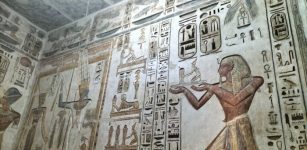 The Gold Compartment At Habu Temple Looks Magnificent After Restoration
Archaeology | Aug 20, 2022
The Gold Compartment At Habu Temple Looks Magnificent After Restoration
Archaeology | Aug 20, 2022 -
 Unique Find: Sacred Gate Found At The Minoan Palace Of Archanes In Crete
Archaeology | Nov 1, 2024
Unique Find: Sacred Gate Found At The Minoan Palace Of Archanes In Crete
Archaeology | Nov 1, 2024 -
 What Caused The Year Without A Summer In 1816?
Ancient History Facts | Sep 17, 2018
What Caused The Year Without A Summer In 1816?
Ancient History Facts | Sep 17, 2018 -
 Anundshög Burial Mound: One Of Sweden’s Richest And Largest Sacred Ancient Sites
Featured Stories | Aug 29, 2018
Anundshög Burial Mound: One Of Sweden’s Richest And Largest Sacred Ancient Sites
Featured Stories | Aug 29, 2018 -
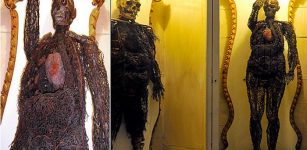 Incredible Anatomical Human Machines – Two Fleshless Bodies Mystery
Featured Stories | Jul 24, 2018
Incredible Anatomical Human Machines – Two Fleshless Bodies Mystery
Featured Stories | Jul 24, 2018 -
 Roman Marble Head Found In Lake Nemi Could Be From Caligula’s Legendary Ships
Archaeology | Jun 28, 2023
Roman Marble Head Found In Lake Nemi Could Be From Caligula’s Legendary Ships
Archaeology | Jun 28, 2023 -
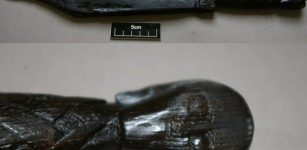 Extraordinary 1,000-Year-Old Viking Sword Discovered In Cork, Ireland
Archaeology | Sep 29, 2017
Extraordinary 1,000-Year-Old Viking Sword Discovered In Cork, Ireland
Archaeology | Sep 29, 2017 -
 What A Bath, Taken 1,000 Years Ago, Can Tell Us About The Conflicted English Kingdom Of The 11th Century
Featured Stories | Jun 14, 2024
What A Bath, Taken 1,000 Years Ago, Can Tell Us About The Conflicted English Kingdom Of The 11th Century
Featured Stories | Jun 14, 2024 -
 Cretaceous Fossil From Antarctica Reveals Earliest Modern Bird
Fossils | Mar 6, 2025
Cretaceous Fossil From Antarctica Reveals Earliest Modern Bird
Fossils | Mar 6, 2025 -
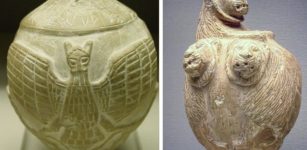 ‘Stone Club Head Of Mesilim’ Probably The Most Powerful Sumerian Ruler At That Time
Artifacts | Oct 12, 2017
‘Stone Club Head Of Mesilim’ Probably The Most Powerful Sumerian Ruler At That Time
Artifacts | Oct 12, 2017 -
 Ponte di Cecco – Legend Of A Bridge Built By An Astrologer With The Help Of The Devil
Featured Stories | Aug 19, 2021
Ponte di Cecco – Legend Of A Bridge Built By An Astrologer With The Help Of The Devil
Featured Stories | Aug 19, 2021 -
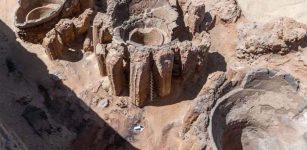 World’s Oldest Beer Factory Discovered In Abydos, Egypt
Archaeology | Feb 16, 2021
World’s Oldest Beer Factory Discovered In Abydos, Egypt
Archaeology | Feb 16, 2021 -
 Puzzling Jewellery From Grave Of High Status Viking Woman Delivered At Museum’s Door
Artifacts | Jul 23, 2022
Puzzling Jewellery From Grave Of High Status Viking Woman Delivered At Museum’s Door
Artifacts | Jul 23, 2022 -
 Mighty Viking Harald Hardrada – The Last Great Viking And Most Feared Warrior Of His Time
Featured Stories | Jun 9, 2020
Mighty Viking Harald Hardrada – The Last Great Viking And Most Feared Warrior Of His Time
Featured Stories | Jun 9, 2020

